This summer I had the chance to watch nymphs of the koppie foam grasshoppers moulting their exoskeletons. I have been keeping an eye on the juvenile grasshoppers as they congregated in greater numbers this season than usual.
The development of these grasshoppers is a surprisingly lengthy process. Hatching from the eggs, the nymphs (also known as hoppers) emerge in the form of miniature adults, but without wings or reproductive organs. As in all grasshoppers their metamorphosis has only three stages – egg, nymph and adult – unlike the majority of insect species that have four stages – egg, larva, pupa, and adult – for example as in butterflies.
Two species of foam grasshoppers conspicuously occur in our garden – the colourful koppie foam grasshopper (Dictyophorus spumans) and the mostly green and black leprous grasshopper (Phymateous leprosus), both members of the Pyrgomorphidae family. Although from different genera these two species have much in common.

These, the smallest juvenile grasshoppers I have photographed in our garden, are koppie foam grasshopper nymphs gathered together on the shade cloth on one side of our vegetable garden
The nymphs of most foam grasshoppers are known to congregate in quite dense aggregations. As they grow they need to moult and shed the previous exoskeleton – in effect their tough exterior skin – in order to accommodate the changes that develop. The different forms at each stage of growth are known as instars. In one study of foam grasshoppers that focussed on the leprous grasshopper, it was observed that a nymph of these grasshoppers moults 10 times, and so it has 10 instars before becoming an adult. The development of the nymph through these 10 juvenile stages takes about a year and in its adult form it lives for around another 8 months (Köhler et al. 2008).

This summer I found these koppie foam grasshopper nymphs clustered on the shady side of a tree trunk in our garden
Foam grasshoppers are so named because they are able to produce a toxic foamy secretion from their thoracic joints when threatened. The foam is so foul-smelling and distasteful that it puts off any creature threatening it. Most foam grasshoppers have conspicuous colours or markings that act as a reminder or warning to predators. The warning must be heeded as eating a toxic foam grasshopper is fatal.

As they develop through successive moults, the instars of the koppie foam grasshopper (Dictyophorus spumans) become more colourful

These grasshoppers eat a wide variety of plants. When they were very young I observed them eating several types of grasses as well as other plants in the garden

Koppie foam grasshopper nymphs eating leaf blades of the broad-leaved bristlegrass (Setaria megaphylla)
It is thought that the toxicity of the foam grasshoppers derives from the poisonous plants that they eat. Although foam grasshoppers are often referred to as milkweed locusts, their diet extends beyond eating milkweeds. (Locusts, by the way, are grasshoppers, with their distinguishing feature being that in response to certain environmental conditions they can form large aggregations resulting in flying swarms of locusts. Otherwise they can live a largely solitary lifestyle much like any other grasshopper.)
Poisonous plants that I observed the koppie foam grasshoppers eating in our garden included arum lilies (Zantedeschia Aethiopica) and also Inanda lilies (Cyrtanthus sanguineus) that they ate right down into the bulb. Fortunately the Inanda lilies are in pots so after removing the grasshoppers, I moved the pots to a more secluded space where all the plants regenerated. The arum lilies were robust enough to survive the grasshoppers feeding on their leaves.
The nymphs also were attracted to eating leaves of the non-indigenous Cape gooseberry (Physalis peruviana) bush in our vegetable garden. It is a member of the deadly nightshade family and the leaves and unripe fruit are toxic.
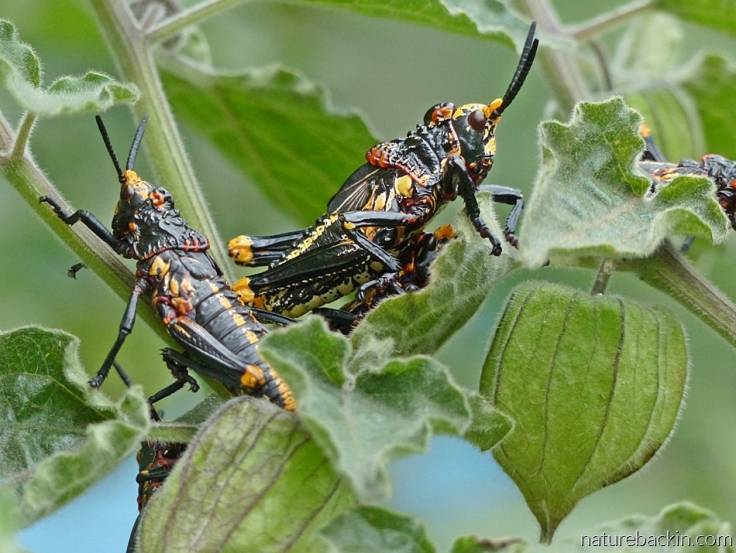
These older koppie foam grasshopper nymphs are feeding on leaves of a Cape gooseberry bush
This summer, because of the extraordinary number of koppie foam grasshoppers in the garden, wearing gloves, my husband carefully placed as many he could find into a sack and relocated them. In previous years we have just left them to do their thing.
Our property backs onto a buffer area between us and an exotic plantation. This area is dense with invasive alien plants. We have cleared a strip and planted indigenous plants, but below that the dense thicket serves to protect small wild animals and birds and provide them with a place to hide from hunting dogs and other threats.
It was here where the grasshoppers were released and they proceeded to make themselves at home, munching on exotic Lantana camara and Caesalpinia decapetala (known as Mauritius thorn)

It was on the Cape gooseberry that I first started noticing the shed exoskeletons of the the koppie foam grasshoppers
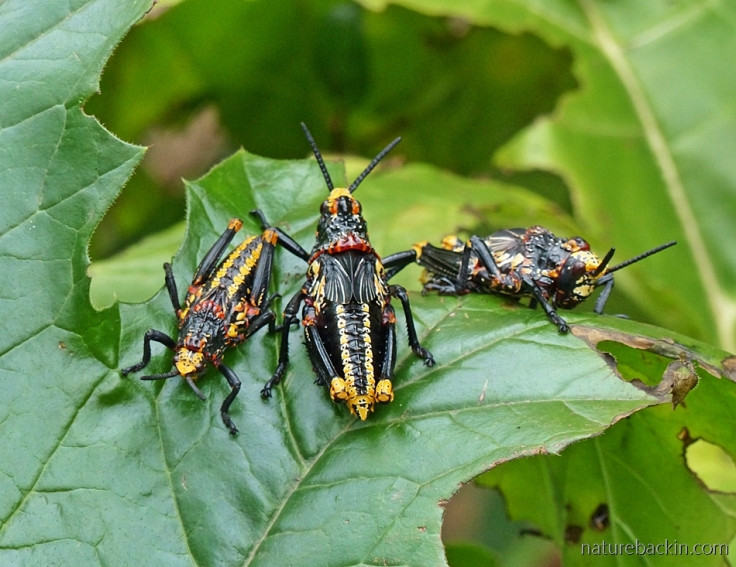
The nymphs that had most recently moulted were showing rudimentary wings for the first time
When I saw the nymphs with wing buds large enough to look like rudimentary wings I was thinking that by the time they reached the adult stage they would fly away, but then I learnt that in fact foam koppie grasshoppers are among the species of grasshopper where the adults remain flightless. In fact they only develop short forewings (tegmina) that in other grasshoppers cover the hind flight wings and koppie foam grasshoppers never grow hind flight wings at all.
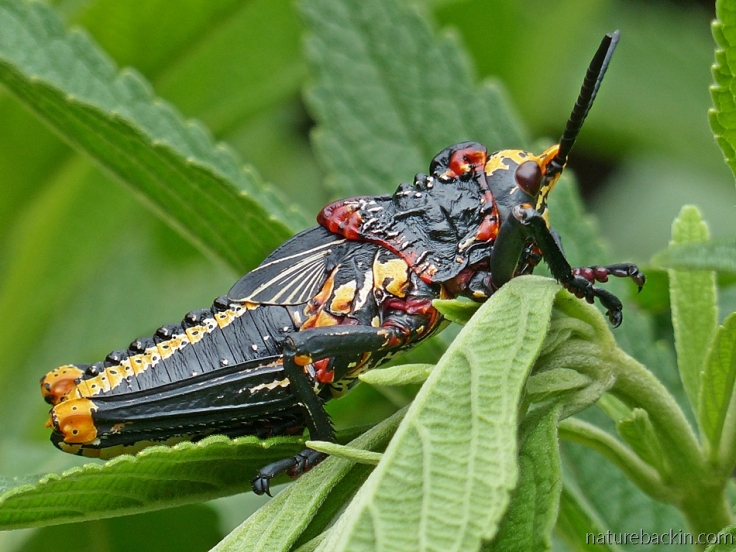
The rudimentary forewings are clearly visible on this individual after the most recent moult

Compare the previous photo to this of an earlier instar where the wing buds are much smaller
I was very excited when I first watched a foam koppie grasshopper shedding its exoskeleton. It is a very slow and apparently arduous process. The first moults that I saw were on dull days and/or windy days and/or obscured by foliage and did not make for successful photographs. Eventually I did see a moult that was easier to photograph.
The moult starts with the face and head of the grasshopper emerging out of a split at the mouth parts of the exoskeleton. The yellow knob at the top of the head and the eyes are soon visible as they protrude from the old exoskeleton as are the “shoulders” or rather the neck shield (pronotum). Next the rest of the head and the antennae (that are folded flat under its front) emerge.
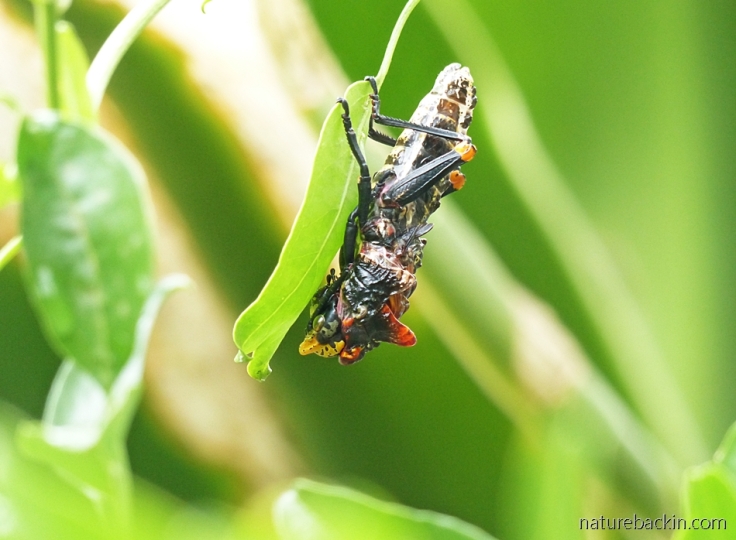
The grasshopper starting to emerge headfirst at the start of shedding the old exoskeleton

Considerable progress has been made, and the grasshopper waves its antennae as the legs start to be freed very slowly from the exoskeleton

The first two pairs of legs are free from the old exoskeleton and the hind legs are starting to emerge

The hindmost legs are now nearly free

The hind legs are free and the end of the abdomen has yet to be released from the old exoskeleton. The process is a bit like slowly oozing out of a very tight sleeping bag. The moment that the abdomen popped out of the old skin is captured in the video below

At last! The grasshopper has successfully escaped from its previous skin. Now it has to be careful while it waits for its new exoskeleton to finish hardening

After 20 minutes since the last photo was taken, the grasshopper is ready to climb away from where it moulted to a more sheltered spot. It is over an hour and a quarter since it first began moulting at the start of this sequence of photographs

After the moulting stage that I observed, this grasshopper is fully recovered from the process

So I continued to keep an eye on the grasshoppers. I did not see any more moults, but I started seeing grasshoppers in their adult colours. In this photo, the grasshopper at the top is in the same nymphal form as the one I photographed moulting. The one below has grown its forewings and displays its adult colours
I did not see any moults into the adult form and neither did I find any more exoskeletons. However, it is unlikely that I photographed the final moult with the grasshopper maturing into an adult in the same exoskeleton. So it appears that somehow I missed observing the last moult in the development process.

This adult is enjoying eating the leaf of a krantz aloe (Aloe arborescens), which seemed to be a favourite food plant also for nymphs at earlier stages of their development. The aloe takes a bit of a hammering but judging from previous years of grasshopper munching, it recovers and although bearing scars it goes on to flower successfully
The colour of these foam koppie grasshoppers is variable in that different forms or morphs of the same species exist. I have only seen this colour morph in our garden. The better known colour morph, predominantly black with red markings, also occurs in KwaZulu-Natal, but I have only seen it in the Western Cape.

I photographed this black and red variant of the koppie foam grasshopper (Dictyophorus spumans) on a permaculture farm near Oudtshoorn in the Western Cape. This colour morph shows why the grasshopper got its Afrikaans name rooibaadjie, which means ‘red jacket’
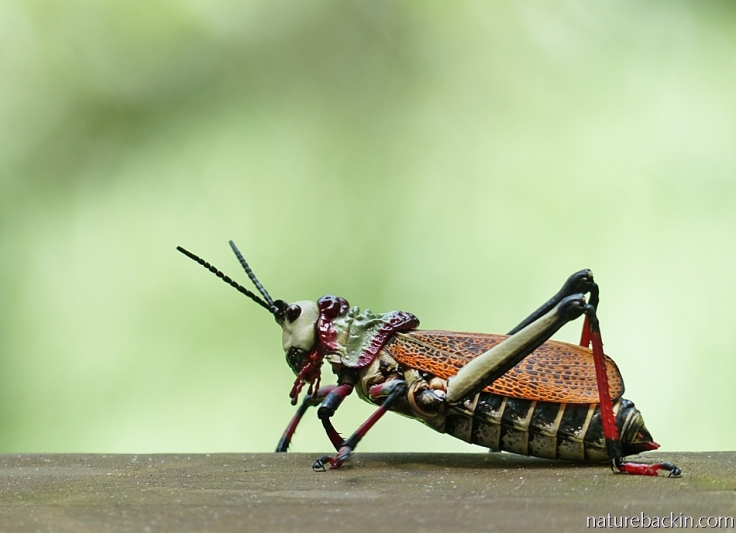
At maturity, the koppie foam grasshopper is large at about 6.5 cm (2.5 inches) in length. Hopefully most animals heed the warning of its conspicuous colours.
I was able to video a grasshopper moulting its skin. The moult is a long and laborious process for the grasshopper, but I found it fascinating to watch. This individual took over an hour and a quarter to complete the process. However, I have edited the video clips down to just under three minutes.

This mature adult koppie foam grasshopper, decorated with water droplets, demonstrates striking good looks that are intended to leave an impression
References:
Köhler, G., S. Roth, S. & Reinhardt, K. 2008. Ten Instars in the Leprous Grasshopper, Phymateus leprosus (Fabricius, 1793) (Caelifera: Pyrgomorphidae): Maximum Number Recorded in the Acridoidea. Bonner zoologische Beiträge, 56: 17–24. https://www.zoologicalbulletin.de/BzB_Volumes/Volume_56_1_2/017_024_BzB56_1_2_K%C3%B6hler_G_et_al.pdf ; Phillipskop Mountain Reserve. [n.d.] Foaming grasshoppers. https://www.phillipskop.co.za/fauna/dictyophorus-spumans; Picker, Mike, Griffiths, Charles & Weaving, Alan. 2019. Field Guide to Insects of South Africa. Cape Town: Struik Nature.
Posted by Carol

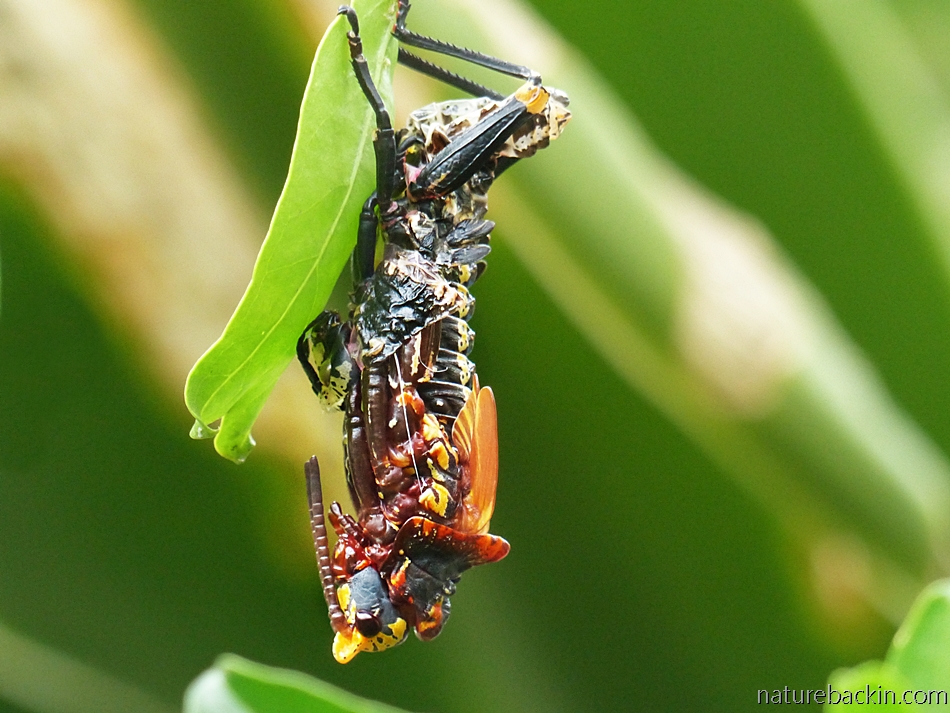






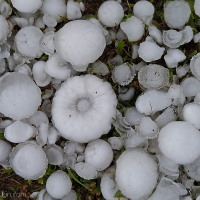
January 30, 2020 at 3:32 am
Pretty amazing video.
LikeLiked by 1 person
January 30, 2020 at 8:12 pm
Thank you Cheryl.
LikeLike
January 30, 2020 at 3:20 am
Such magical moments beautifully captured, thank you Carol! xxx
LikeLiked by 1 person
January 30, 2020 at 8:11 pm
Thank you Christeen 🙂
LikeLiked by 1 person
January 26, 2020 at 3:11 am
What a great post. A ton of information and the photos are fantastic. They’re such colorful little beasts, but I think my favorite photo is the grasshopper covered screen. It’s mesmerizing, like a still from a techno music video! I find moulting to be such a weird, inexplicable process, but you have demystified it for me.
LikeLiked by 1 person
January 29, 2020 at 7:51 pm
Thanks Graham. I think I need to check out some techno music videos! Moulting is a mysterious process – it seems to be quite traumatic for the locust too, and they must feel very vulnerable and disabled throughout the long process.
LikeLiked by 1 person
February 1, 2020 at 4:37 am
Yes, having to wait for the exoskeleton to harden must be a vulnerable time. Reminds me, as things often do, of a Far Side cartoon called Metamorphosis, where the struggle of a butterfly to emerge is shown only for two of the ‘berries’ on the plant to be frog’s eyes with predictable results!
LikeLiked by 1 person
February 5, 2020 at 6:13 pm
Now that you mention it, I think I remember that Far Side cartoon too – brilliant in Gary Larson’s wry kind of way.
LikeLiked by 1 person
February 6, 2020 at 4:53 am
One of his early ones, when the strip was called Nature’s Way.
LikeLiked by 1 person
January 25, 2020 at 4:36 pm
Your video is hypnotic; I was quite mesmerised by the emerging nymph. Hard to imagine that it fitted inside the small discarded exoskeleton. Stunning piece as always, Carol.
LikeLiked by 1 person
January 29, 2020 at 7:49 pm
Thanks Sandra. Yes I found it strangely compelling to watch. In one dimension not a lot seems to be happening, but in actual fact it is a dramatic process – albeit in slo-mo.
LikeLiked by 1 person
January 24, 2020 at 7:08 pm
wow! cool and creepy at the same time
LikeLiked by 1 person
January 24, 2020 at 7:28 pm
Thank you Buddy. Yes I agree – I had to keep in mind that their striking appearance is really signalling that one must keep one’s distance!
LikeLike
January 24, 2020 at 6:20 pm
Totally fascinating and these grasshoppers are so colourful. Your photos are very sharp and I hope the relocation worked out well for all! What eats these rather toxic creatures?
LikeLiked by 1 person
January 24, 2020 at 7:24 pm
The relocated grasshoppers have dispersed into dense vegetation. It was difficult to decide to move them, but the numbers were just so high. My husband counted up to 700 grasshoppers in his first collection, and over 200 in the second group he relocated.
As far as I am aware nothing can eat these koppie foam grasshoppers and survive. My insect field guide states that the toxins they extract and store are heart poisons (cardiac glycosides). Eating just one will kill a dog or even a human, for example. From what I can make out, they are sensitive to changes in weather and other environmental circumstances and over time their numbers wax and wane accordingly.
LikeLike
January 25, 2020 at 11:03 am
Fascinating, so they just devour vegetation! And then in harder times die off.
LikeLiked by 1 person
January 24, 2020 at 4:56 pm
Excellent, Carol. Super impressed. David Attenborough eat your heart out. All you need now is the ”Voice”.
🙂
LikeLiked by 1 person
January 24, 2020 at 7:01 pm
Thank you so much Ark. Actually I have been recording some interesting bird calls, but unfortunately it is not always possible to get the visuals too (for when the chairs get turned around).
LikeLiked by 1 person
January 24, 2020 at 7:47 am
I will encourage ours to jump over the fence and join your troupe. Wow! that must have taken all week and more to photograph.
LikeLiked by 1 person
January 24, 2020 at 6:56 pm
Thanks John. Yes I was out quite a bit with the camera 🙂 At one point I nearly missed taking the bread out of the oven when it had finished baking …
LikeLike
January 24, 2020 at 6:45 am
Fascinating! And what a colorful fellow he is!
LikeLiked by 1 person
January 24, 2020 at 6:55 pm
Thanks so much. Colourful indeed!
LikeLiked by 1 person
January 24, 2020 at 6:27 am
This is a stunning piece of observation. As the previous commenters observe, this deserves a much wider audience.
LikeLiked by 1 person
January 24, 2020 at 6:54 pm
Thank you Margaret. I could not think of a riveting title 🙂 But perhaps over time more readers will find their way to this post.
LikeLiked by 1 person
January 26, 2020 at 10:01 am
Your title is fine. It does what it says on the tin.
LikeLiked by 1 person
January 29, 2020 at 7:52 pm
🙂
LikeLike
January 24, 2020 at 4:40 am
You have outdone yourself on this one, Carol. This is an incredible focus on an aspect of nature that would pass by most people. You have brought both your patience and your photographic skills to the fore – to the enrichment and elucidation of the rest of us. I have found this very interesting and hope that you will be able to share it with a wider audience by giving an illustrated talk, for example.
LikeLiked by 2 people
January 24, 2020 at 6:48 pm
Thank you very much Anne. I am so pleased that you also found the grasshoppers to be interesting. I think some people find such creatures to be so unappealing that they are unable to find them interesting. I love discovering such fascination going on right under our noses.
LikeLike
January 24, 2020 at 2:39 am
Again you have left me in awe at your wonderful photographs and the lengths you go to to bring us these fascinating posts, Carol!
I am glad you emphasized just how poisonous these locusts are. I find them terribly scary and get chills just at the thought of one crawling in my neck, but I often see people picking them up or allowing their pets to pester the grasshoppers, which could have very sad consequences if any of the “foam” makes it to their mouths…
LikeLiked by 2 people
January 24, 2020 at 6:42 pm
It would seem that the grasshoppers have to feel under extreme threat to release the foam, which is probably quite a debilitating process for them. Of the literally hundreds of grasshoppers that my husband caught and relocated, not one of them responded by releasing foam. However, as you say they are not to be messed with.
Thank you for overcoming your aversion enough to read my post 🙂
LikeLiked by 1 person
January 25, 2020 at 2:59 am
😀
So long as the photos don’t start twitching their legs I’ll be fine!
😀
LikeLiked by 1 person
January 25, 2020 at 8:19 am
That’s good. 🙂 I know someone who can’t tolerate seeing even photos of reptiles! I once saw her turn the page of book to come across an unexpected photo of a lizard and she got such a fright that she reflexively hurled the book across the room!
LikeLiked by 1 person
January 26, 2020 at 2:29 am
Wow, Carol, that must be a difficult phobia to cope with.
LikeLiked by 1 person
January 24, 2020 at 1:17 am
Fascinating process – quite miraculous when you think about it! Excellent and well researched post, Carol.
LikeLiked by 1 person
January 24, 2020 at 6:39 pm
It is miraculous. I am glad I took a closer look, and thanks Eliza.
LikeLike
January 24, 2020 at 12:41 am
Simply amazing documentary, Carol.
LikeLiked by 1 person
January 24, 2020 at 6:38 pm
Thanks very much Sandy,
LikeLiked by 1 person
January 24, 2020 at 7:52 pm
My pleasure.
LikeLiked by 1 person